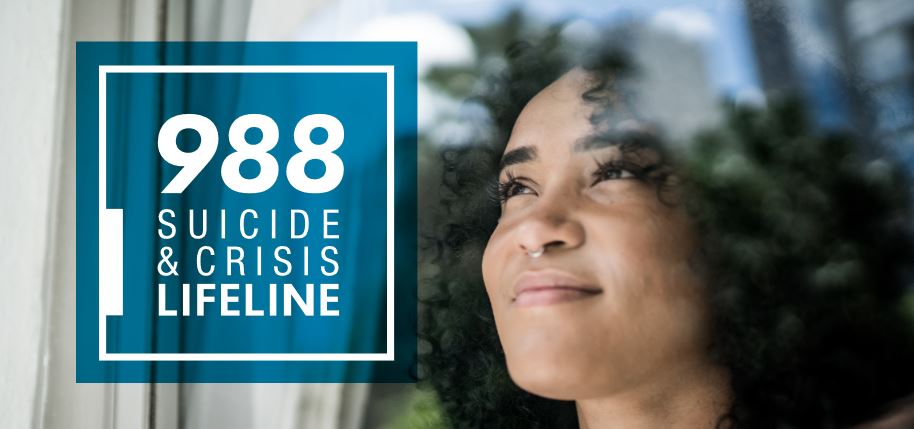Updated: August 2025
Dial the 3-digit code 988 to connect to the National Suicide and Crisis Lifeline. The 988 dialing code was first launched in the US in 2022, and was added in Canada in 2023. This 3-digit number offers a memorable, easy path to access services. The Lifeline offers free, confidential support to people in suicidal crisis or mental health-related distress 24 hours a day, 7 days a week.
Memorize the new 988 Suicide and Crisis Lifeline number and share it with family, friends, and colleagues. We don’t always know the problems that people around us are struggling with – even those very close to us. Sharing the news about 988 and its services might save a life or lift a burden. Here are a few facts you should know about the 988 Lifeline.
What happens when you call?
“When calling 988, callers first hear a greeting message while their call is routed to the local Lifeline network crisis center (based on the caller’s area code). A trained crisis counselor will answer the phone, listen to the caller, understand how their problem is affecting them, provide support, and share resources if needed. If the local crisis center is unable to take the call, the caller will be automatically routed to a national backup crisis center. The Lifeline provides live crisis center phone services in English and Spanish and uses Language Line Solutions to provide translation services in over 250 additional languages for people who call 988.”
How is 988 different from 911
988 was established to improve access to crisis services in a way that meets our country’s growing suicide and mental health-related crisis care needs. 988 will provide easier access to the Lifeline network and related crisis resources, which are distinct from the public safety purposes of 911 (where the focus is on dispatching Emergency Medical Services, fire and police as needed).
Will the 1-800-273-8255 go away when we switch to 988?
Moving to 988 does not mean the 1-800-273-8255 number goes away. After July 16, 2022, using either number will get people to the same services. In the end, 988 is an easier-to-remember way to access a strengthened and expanded network of crisis call centers.
See more 988 Frequently Asked Questions
The need for better suicide prevention and mental health resources
With an increase in mass shootings, the need for better access to mental health services is a constant refrain. While it should be noted that people with mental illnesses are more likely to cause self-harm or be victims of violence than to inflict harm on others (see Addressing Misconceptions about Mental Health and Violence), mental health problems are more common than most people think. We often don’t talk about this enough because of lack of knowledge, misunderstanding, or fear of stigma. According to MentalHealth.gov, as of 2020:
- One in five American adults experienced a mental health issue.
- One in 6 young people experienced a major depressive episode.
- One in 20 Americans lived with a serious mental illness, such as schizophrenia, bipolar disorder, or major depression.
- Suicide was the 2nd leading cause of death for people ages 10-24.
Suicide is a national problem. The Kaiser Family Foundation (KFF( has recent statistics on the scope of the nation’s suicide problem: “Nearly half a million lives (480,622) were lost to suicide from 2010 to 2020. During the same period, the suicide death rate increased by 12% and as of 2009, the number of suicides outnumbered those caused by motor vehicle accidents.”
In addition, KFF notes that:
- Suicide deaths increased between 2010 and 2018 and then slowed in 2019 and 2020, although some research suggests suicide deaths are under counted.
- Suicide deaths by firearms accounted for more than half of all suicides in 2020.
- Suicide death rates in 2020 were highest among American Indian and Alaska Native people, males, and people who live in rural areas
- Suicide deaths are increasing fastest among people of color, younger individuals, and people who live in rural areas.
- Suicide death rates varied substantially by state in 2020, as did the rate of change from 2010 to 2020.
Reminder to Members of ESI EAP: If you are a member of ESI EAP, you have 24/7/365 access to a helpline and to an online self-help portal to access counseling, coaching, and a wide array of benefits and resources to help you address problems, grow, and thrive both at home and at work. However, while your EAP provides in-the-moment help for any mental health issues you may face, if you or someone you love is feeling suicidal or facing an immediate or life-threatening mental health or substance abuse crisis, then 988 – or in some cases 911 – are the best resources to use.
Related resources from our archives:
- May is the month to raise your mental health awareness
- Feeling angry, stressed, or anxious? Get help!

